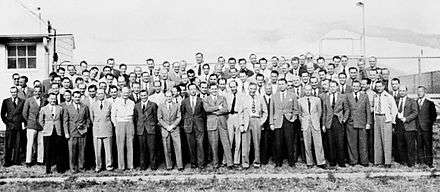Ernst Steinhoff
| Ernst Steinhoff | |
|---|---|
| Born |
February 11, 1908 Treysa Germany |
| Died |
December 2, 1987 (aged 79) Alamogordo, New Mexico |
| Nationality |
|
| Fields | Aeronautics, Meteorology, Engineering |
| Institutions |
Peenemünde Army Research Center Fort Bliss Holloman Air Force Base |
| Alma mater | Darmstadt University of Technology |

Ernst August Wilhelm Steinhoff (February 11, 1908 – December 2, 1987)[1] was a rocket scientist and member of the "von Braun rocket group", at the Peenemünde Army Research Center (1939-1945). Ernst Steinfhoff was an avid Nazi who saw National Socialist doctrines as "ideals" and became a member of the NSDAP in May 1937.[2] He was a glider pilot, helding distance records and had the honorary Luftwaffe rank of "Flight Captain".
Ernst Steinhoff earned his PhD at the Darmstadt University of Technology in 1940 with a dissertation on aviation instruments.
His younger brother Friedrich Steinhoff assisted rocket experiments while commanding U-511 in 1942.[3] Ernst was among the scientists to surrender and travel to the United States to provide rocketry expertise via Operation Paperclip. Friedrich was captured aboard U-873 and committed suicide in a Boston jail[3] before Ernst came to the United States on the first boat, November 16, 1945.[4] with Operation Paperclip and Fort Bliss, Texas (1945-1949). He then moved to Holloman Air Force Base where he also worked closely with White Sands Missile Range in New Mexico. He focused on guidance, control, and range instrumentation throughout his career.[1][5] He was awarded the Decoration for Exceptional Civilian Service in 1958 for his contributions to the US rocket program.[6] In 1979 he was inducted into the New Mexico International Space Hall of Fame.[1]
Steinhoff is being credited as one of the first pioneers to popularize the concept of space resource utilization for Mars exploration.[7] He became the first chairman of Working Group on Extraterrestrial Resources (WGER).
References
- 1 2 3 "ERNST A. STEINHOFF". International Space Hall of Fame. New Mexico Museum of Space History. Retrieved December 14, 2010.
- ↑ Michael Neufeld: The Rocket and the Reich: Peenemünde and the Coming of the Ballistic Missile Era, Harvard University Press, 1996, ISBN 067477650X
- 1 2 "Friedrich Steinhoff". Guðmundur Helgason. Retrieved 2012-10-05.
- ↑ "Steinhoff, Ernst". Astronautix. Retrieved December 14, 2010.
- ↑ "Dr. Ernst Steinhoff". White Sands Missile Range Hall of Fame. White Sands Missile Range Museum. Retrieved December 14, 2010.
- ↑ Stuhlinger, E., Ordway, F.I., McCall, J.C., and Bucher, G.C. (1963) Aeronautical Engineering and Science, McGraw-Hill.
- ↑ " "A Forgotten Pioneer of Mars Resource Utilization (1962-1963)".